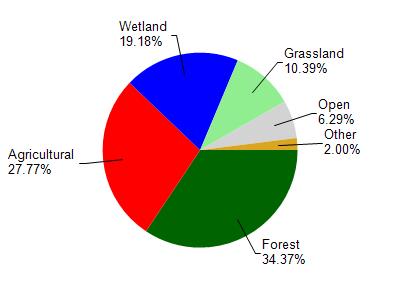Waushara
No
No
Yes
Fish and Aquatic Life
Overview
Pine River and Willow Creek are clear, hard water streams that drain the center two-thirds of Waushara County. There are substantial critical animal waste problems in the eastern half of this watershed, though detailed inventories need to be done. Soil erosion, at rates above 2 T/A/YR, combined with local animal waste delivery and in-stream erosion have accelerated deterioration of trophic status of mill ponds on the Pine River and Willow Creek.
Willow Creek is a 43-mile-long tributary to the southwest corner of Lake Poygan and is entirely within Waushara County. The portion of Willow Creek above Redgranite is listed as an Outstanding Resource Water.
Fluctuating water levels due to the hydroelectric dam at the Auroraville Millpond conflicts with recreational uses. Streambank erosion occurs when water levels are high. Stream bank brushing and in-stream structures have been implemented in the Class I portion resulting in improved stream conditions in approximately six miles. Mechanical brushing is planned where necessary in the Class II portion.
From: Bougie, Cheryl A., Kosmond, Lisa D, and Watermolen, Dreux J. 1996. Wolf River Basin Water Quality Management Plan. Wisconsin Department of Natural Resources, Madison, WI.
Date 1996
Author Cheryl Bougie
Impaired Waters
Willow Creek, from its mouth to an Unnamed Tributary (WBIC 244400) (miles 0 to 9.56), was placed on the impaired waters list in 2016 for elevated temperature, an impairment confirmed in the 2018 cycle. Evaluations of phosphorus and chloride found no additional impairment.
Willow Creek, from Unnamed Tributary WBIC 244400 to Auroraville Millpond (miles 9.56 to 12.11), was evaluated in the 2014 and 2018 cycles. Phosphorus, chloride, and biological data showed no impairment. This segment is on the Healthy Waters List.
Willow Creek, from Auroraville Millpond to 29th Lane (miles 13.24 to 14.19), was listed for temperature in the 2018 cycle.
Willow Creek, 29th Lane downstream to Blackhawk Rd (miles 14.19 to 30.44), was identified as impaired for elevated water temperature (cause unknown) in 2018. Subsequent evaluations confirmed this impairment (2020 and 2022 cycles). This segment of Willow Creek was evaluated every two-year cycle from 2016 to 2022; phosphorus, bug, and fish data indicated a healthy system.
Willow Creek, Blackhawk Rd. to the headwaters (miles 30.43 to 42.34), was assessed during the 2018 listing cycle; new biological (fish Index of Biotic Integrity (IBI) scores) and temperature sample data showed good conditions. This segment is on the Healthy Waters List.
Date 2018
Author Ashley Beranek
Condition
Wisconsin has over 84,000 miles of streams, 15,000 lakes and milllions of acres of wetlands. Assessing the condition of this vast amount of water is challenging. The state's water monitoring program uses a media-based, cross-program approach to analyze water condition. An updated monitoring strategy (2015-2020) is now available. Compliance with Clean Water Act fishable, swimmable standards are located in the Executive Summary of Water Condition in 2018. See also the 'monitoring and projects' tab.
Reports
Recommendations
Citizen-Based Stream Monitoring
Collect chemical, physical, and/or biological water quality data to assess the current overall stream health. The data can inform management decisions and may be used to identify impaired waters for biennial lists.
Restore Wetlands
Restore Wetlands
Restore Wetlands
Restore Wetlands
Management Goals
Wisconsin's Water Quality Standards provide qualitative and quantitative goals for waters that are protective of Fishable, Swimmable conditions [Learn more]. Waters that do not meet water quality standards are considered impaired and restoration actions are planned and carried out until the water is once again fishable and swimmable
Management goals can include creation or implementation of a Total Maximum Daily Load analysis, a Nine Key Element Plan, or other restoration work, education and outreach and more. If specific recommendations exist for this water, they will be displayed below online.
Monitoring
Monitoring the condition of a river, stream, or lake includes gathering physical, chemical, biological, and habitat data. Comprehensive studies often gather all these parameters in great detail, while lighter assessment events will involve sampling physical, chemical and biological data such as macroinvertebrates. Aquatic macroinvertebrates and fish communities integrate watershed or catchment condition, providing great insight into overall ecosystem health. Chemical and habitat parameters tell researchers more about human induced problems including contaminated runoff, point source dischargers, or habitat issues that foster or limit the potential of aquatic communities to thrive in a given area. Wisconsin's Water Monitoring Strategy was recenty updated.
Grants and Management Projects
Monitoring Projects
| WBIC | Official Waterbody Name | Station ID | Station Name | Earliest Fieldwork Date | Latest Fieldwork Date | View Station | View Data |
|---|
| 243700 | Willow Creek | 703091 | Willow Creek at 29 Ln | 6/9/2005 | 1/1/2015 | Map | Data |
|

Watershed Characteristics
Willow Creek is located in the Pine and Willow Rivers watershed which is 302.08 mi². Land use in the watershed is primarily forest (34.40%), agricultural (27.80%) and a mix of wetland (19.20%) and other uses (18.70%). This watershed has 377.48 stream miles, 11,273.01 lake acres and 33,136.61 wetland acres.
Nonpoint Source Characteristics
This watershed is ranked High for runoff impacts on streams, Not Ranked for runoff impacts on lakes and High for runoff impacts on groundwater and therefore has an overall rank of High. This value can be used in ranking the watershed or individual waterbodies for grant funding under state and county programs.However, all waters are affected by diffuse pollutant sources regardless of initial water quality. Applications for specific runoff projects under state or county grant programs may be pursued. For more information, go to surface water program grants.